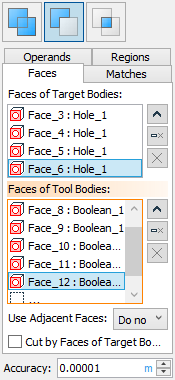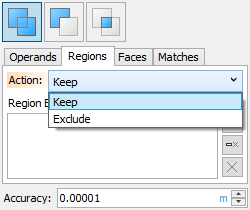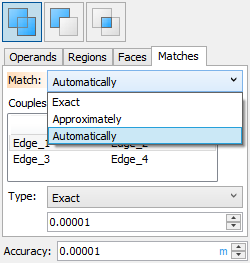General Parameters of Boolean Operation |
  
|
Selecting Boolean type
The operation type is selected in the General Parameters tab:
|
<+> |
Addition |
|
<-> |
Subtraction |
|
<*> |
Intersection |
When the Boolean operation is called first time in a session, the Boolean operation type Addition is automatically set in the automenu. On subsequent calls to the Boolean, the default button will be the type used in the previously called Boolean.
Selecting operands of the global Boolean operation
To select operands of a global Boolean operation, use the following option:
|
<1> |
Select Boolean operands |
At this point, the options become available in the automenu:
|
<F> |
Select 1st body |
|
<S> |
Select 2nd body |
As one of these options is activated, the input focus switches to the respective pane of selecting targets or tools in the parameters window. Vice versa, as you switch the focus between the selected operands panes in the parameters window, the respective options activate in the automenu. Target and tool bodies can be selected either directly in the 3D scene or in the 3D model tree. Target bodies are highlighted green in the scene, tools – yellow. An operand selected in the parameters window is highlighted blue in the scene. To delete any operand from the list, select it in the Parameters window, and then press the buttons Delete Element from the List or Clear. Once the Boolean operation is created, the operand bodies will be removed from the scene, with only the resulting body left.
Selecting operands for the local Boolean operation
To enter the mode of selecting faces for creating a local Boolean operation, one can use the automenu option:
|
<3> |
Select local faces |
Alternatively, to activate this mode, you can switch to the Faces tab in the Parameters window.
At that time, the following options become available in the automenu:
|
<F> |
Select local faces for first Operands |
|
<S> |
Select local faces for second Operands |

Once the operands are selected, you can proceed with selecting bodies' faces for creating a local Boolean operation. You can do this in the scene by the mentioned automenu options or by focusing on the pane of the Faces tab. When creating a Boolean operation, you can skip selecting operands and directly proceed to the mode of selecting faces. In this case, the bodies, whose faces are selected, will be automatically added as operands on the respective tab in the operation parameters. Highlighting of the target and tool faces is analogous to that of the bodies-operands. To remove a face, select it in the list on the Faces tab, and then press the buttons Delete Element from the List or Clear. In some cases, you may need to turn on the option Cut by Faces of Target Bodies to insure the correct operation result.
When creating a local Boolean operation, you can engage faces adjacent to the selected face. To do this, select the respective entry in the combo box of the Use Neighbor Faces parameter.
Selecting parts of operands
To create a selective Boolean operation, use the following option:
|
<2> |
Select parts of operands |
Alternatively, to activate this mode, you can switch to the Regions tab in the Parameters window. In this case, the following options become available in the automenu:
|
<S> |
Select element that indicates part of operand |
|
<H> |
Select point that indicates part of operand |

With these options, you can select the elements defining the operands' pieces. The names of the selected elements will be added to the list on the Regions tab in the Parameters window. On the same tab, you can select the action for the selected pieces of the operands: leave those in the resulting body, or exclude. The selected action will work on all selected pieces of the operands.
Setting element matches
To define element matches, use the option:
|
<4> |
Select matches |
Alternatively, to activate this mode, you can switch to the Matches tab in the Parameters window. Then, the following options become available in the automenu:
|
<F> |
Select first match Element |
|
<S> |
Select second match Element |

Use these options to select pairs of elements for defining matches. The names of the selected elements are displayed on the Matches tab in the Parameters window. Each pair of elements can be assigned the exact or approximate ("tolerant") matching option. The type of match is selected from the Type combo box on this tab.
Note that the set of match types in this combo box can vary, depending on the particular combination of element topologies in a pair (see the table in the section Setting Element Matches in Boolean Operation).
The matching tolerance can be specified on this tab.
Preview of Boolean Operations Results
To preview the result of a Boolean operation and also the changes introduced by a Boolean operation it is required to use the preview option in the automenu or a similar button in the parameters window:
|
<F5> |
Preview result of operation |
|
<Ctrl+F5> |
Preview changes introduced by operation |